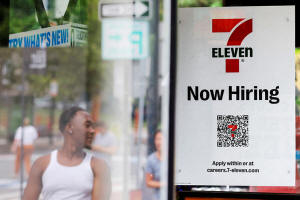US labor market losing steam as unemployment rate climbs to 4.1%
 Send a link to a friend
Send a link to a friend
 [July 06, 2024] By
Lucia Mutikani [July 06, 2024] By
Lucia Mutikani
WASHINGTON (Reuters) - U.S. employment increased solidly in June, but
government and healthcare services hiring made up about three-quarters
of the payrolls gain and the unemployment rate hit a 2-1/2-year high of
4.1%, pointing to a slackening labor market that keeps the Federal
Reserve on course to start cutting interest rates soon.
The Labor Department's closely watched employment report on Friday also
showed the economy created 111,000 fewer jobs in April and May than
previously estimated, suggesting the trend in payrolls growth was
slowing.
Annual wages increased at the slowest pace in three years amid an
expanding labor pool, adding to the flashing warning signals in the jobs
market. About 277,000 people joined the labor force, accounting for the
increase in the jobless rate from 4.0% in May to the highest level since
November 2021.
When added to the moderation in prices in May, the report could boost
Fed policymakers' confidence in the inflation outlook after the
disinflationary trend was disrupted in the first quarter. Financial
markets expect the U.S. central bank, which aggressively tightened
monetary policy in 2022 and 2023, to start its easing cycle in
September.
"We now have definitive evidence of labor market cooling with a somewhat
alarming rise in the unemployment rate in recent months that should give
policymakers 'more confidence' that consumer inflation will soon return
to the 2.0% target on a sustainable basis," said Scott Anderson, chief
U.S. economist at BMO Capital Markets.

Nonfarm payrolls increased by 206,000 jobs last month, lifted by
government hiring, the Labor Department's Bureau of Labor Statistics
said. Economists polled by Reuters had forecast payrolls would increase
by 190,000 last month, with the unemployment rate unchanged at 4.0%.
Job growth has averaged about 222,000 per month in the first half of
this year. Analysts estimate the economy needs to create between 180,000
and 200,000 jobs per month to keep up with growth in the working-age
population, taking into account a recent surge in immigration.
A lagging measure of employment, the Quarterly Census of Employment and
Wages (QCEW), has suggested a much slower pace of job growth through the
fourth quarter of 2023 than that of the payrolls data.
The QCEW data is derived from reports by employers to the state
unemployment insurance (UI) programs. While economists expect employment
to be revised down when the BLS in August publishes its payrolls
benchmark estimate for the 12 months through March of this year, they
argued that the QCEW data does not include unauthorized immigrants, a
group that they believe contributed to strong job growth last year.
Though hiring in June continued to be driven by acyclical sectors like
healthcare and state and local governments, the share of industries
reporting job growth jumped to 59.6% from 56.4% in May.
Government employment surged by 70,000 jobs, the most since December,
boosted by local government, excluding education and state government.
Private payrolls increased by 136,000, with the healthcare and social
assistance sector adding 82,400 positions.
Construction payrolls rose by 27,000. But the retail sector shed jobs,
as did manufacturing. Professional and business services employment
declined by 17,000 jobs, with temporary help jobs dropping by about
49,000, the most since April 2020. That likely portends slower payrolls
gains ahead.
"So far, we don't see apocalyptic signs within the labor market, but
investors should be wary when the labor market is supported by
government payrolls," said Jeffrey Roach, chief economist at LPL
Financial. "The downward revisions to the previous two months is
consistent with an economic slowdown."
[to top of second column] |

A 7-Eleven convenience store has a sign in the window reading "Now
Hiring" in Cambridge, Massachusetts, U.S., July 8, 2022.
REUTERS/Brian Snyder/File Photo

Stocks on Wall Street were trading mostly higher. The dollar slipped
versus a basket of currencies. U.S. Treasury prices rose.
WAGE GROWTH SLOWS
The 525 basis points worth of rate hikes from the Fed since 2022 as
well as the exhaustion of excess savings accumulated during the
COVID-19 pandemic are eroding demand.
Traders of federal funds futures saw a roughly 77% probability of a
rate cut at the Fed's Sept. 17-18 meeting, according to CME Group's
FedWatch tool. Traders are also pricing in a rising chance of a
second rate cut in December.
The Fed has maintained its benchmark overnight interest rate in the
current 5.25%-5.50% range since last July. The minutes of the
central bank's June 11-12 meeting, which were published on
Wednesday, showed policymakers acknowledged the economy appeared to
be slowing and that "price pressures were diminishing."
Average hourly earnings rose 0.3% last month after advancing 0.4% in
May. In the 12 months through June, wages increased 3.9%. That was
the smallest gain in wages since June 2021 and followed a 4.1% rise
in May. Wage growth in a 3%-3.5% range is seen as consistent with
the Fed's 2% inflation target.
Despite its underlying softer details, the employment report was
consistent with continued economic expansion. Nonetheless, the
second straight monthly increase in the unemployment rate could be
signaling a rise in joblessness.
The household survey from which the jobless rate is derived showed
employment rebounding by 116,000 in June, not enough to match
supply. The unemployment rate has increased six-tenths of a
percentage point from a low of 3.5% last July.
The household survey has shown minimal job growth compared to
nonfarm payrolls.
"We have very good reason to think that the household survey is
underestimating immigration, contributing to the underperformance
versus payrolls," said Preston Caldwell, chief U.S. economist at
Morningstar.
The number of people experiencing long spells of unemployment
increased 166,000 to 1.516 million in June, but fewer people
reported working part-time for economic reasons.

The labor force participation rate, or the proportion of working-age
Americans who have a job or are looking for one, rose to 62.6% from
62.5% in May.
The participation rate for prime-age workers, those aged 25 to 54,
increased to 83.7%. That was the highest level since February 2002
and was up from 83.6% in May.
"The labor market is chugging along for now, but evidence is
mounting that if it continues to slow down, it could stall," said
Nick Bunker, the economic research director for North America at
Indeed Hiring Lab.
(Reporting by Lucia Mutikani; Editing by Chizu Nomiyama and Paul
Simao)
[© 2024 Thomson Reuters. All rights
reserved.]
This material may not be published,
broadcast, rewritten or redistributed.
Thompson Reuters is solely responsible for this content. |